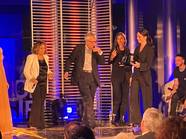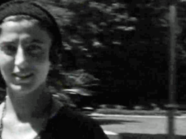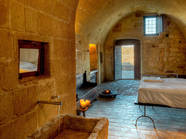About a month ago, Paul D’Ambrosio, a colleague and Facebook friend, asked me if Ralph Fasanella’s painting Welcome Home Boys was still in the Oakland Public Library’s main branch. I live 2.5 miles from the library and visit it regularly, but I had to admit to Paul—Fasanella scholar and Chief Curator of the Fenimore Art Museum in New York—that not only had I never seen it, I didn’t even know such a painting was exhibited here on the West Coast.
Several Google searches that night showed conflicting information—that the painting is both at the Oakland Public Library and at the Oakland International Airport. D’Ambrosio told me that the painting’s owners originally wanted to hang it at the airport, but that he had seen it at the library in the mid-1990s: “I recall it being hung up over an archway in one of the reading rooms. I had to search for it as none of the librarians knew what I was talking about” (Facebook email exchange, Feb. 6, 2011).
And so, last week I started asking some questions.
Tuesday, February 22, 2011 ~ a visit to the main branch of the Oakland Public Library.
I had never really paid attention to the library’s interior walls before, and I was saddened to notice that they were mostly bare and in need of fresh paint. I looked around a bit and then walked to the second floor, where the Oakland History Room is, passing the hallway of historical photographs of Oakland, many of them documenting Oakland’s Italian working class history. I found myself thinking, surely the watchful eyes of this ethnic enclave wouldn’t let a Fasanella disappear from right under their noses.
 Photography-filled Hallway Leading to the Oakland History Room
Photography-filled Hallway Leading to the Oakland History Room
In the History Room I asked the librarian, Maggie, if she knew if there was a Ralph Fasanella painting somewhere in the library, possibly in the Art and Music Department (as per one of the websites):
Hmm….Yes, this (pointing across the room) used to be the Art and Music Department, but that was a long time ago. Does the painting have to do with Oakland? Otherwise, it would not be in this room. Try Jade, downstairs at the reference desk—if it was ever here, she’ll know.
Jade was nowhere to be found that afternoon; I left my card and scribbled down a note about what I was looking for. I returned to the History Room to find Maggie Googling information for me “Famanella… Fazarella….” Of course, she wasn’t having any luck.
A few hours later, Jade left me a message—Yes, the painting used to hang at the library. We spoke later, and she told me that there were a few folders with “internal memos” regarding the painting; Jade would talk to her boss, get permission for me to see the memos, and be in touch. The next day we spoke again and made an appointment for that Saturday.
Saturday, February 26, 2011 ~ back to the library
I met Jade, who handed me a folder but told me that there were other documents, more “internal memos,” that the library didn’t want me to see. She suggested that all the information I needed would be found in the folder she handed me and that the other memos pointed to some nasty, local politics, and it was best for those names not to get out. I didn’t push it.
The memos and newspaper clippings I looked through detailed that the painting was bought in 1990 for $53,000 ($43,000 was put up by a local union, Local 790, and $10,000 by the Oakland Public Art Fund). It was part of the nationwide Public Domain Project, whose goal was to put all of Fasanella’s paintings into public spaces. Fasanella (1914-1997) was an Italian American painter from New York, whose work is generally described as heavily connected to his ethnic background, progressive politics, and experience in the US labor movement. As a 1989 press release put out by the SEIU Local 535 describes, Welcome Home Boys
depicts a post World War II strike. A multi-racial group of women seeking equal pay and men seeking relief from wage losses resulting from the wartime no-strike pledges are marching in front of a waterfront factory or warehouse.
In short, it was an ideal piece of public art for the people of Oakland.
The painting had been designated to go to the Oakland Airport, but later it was determined that there was no place for it there. And so in December 1992 it was hung at the Oakland Public Library’s main branch, which is where Paul D’Ambrosio saw it.
Jade told me that the reference librarians used to be able to look at it from their desks when they worked.
 The Library Wall I Understand to Be Where The Painting Was Last Displayed
The Library Wall I Understand to Be Where The Painting Was Last Displayed
The memos also suggest that the painting was removed from the library around 1997 because it needed to be repaired, and that it stayed in storage at the Oakland Museum from 1997 until 2003, when funds were at last found to restore it. (Since I moved to Oakland in 1998, I couldn’t have seen the painting as it had already been removed from the library by then.)
Monday, February 28, 2011 ~ phone calls, emails
I called my contacts at the Oakland Museum and quickly ended up talking to Pauline, the painting restorer, who told me: “I’m fairly certain that it’s not here,” and then called me back to tell me that the file from that time period is difficult to get to because that database has since crashed. She also explained that such restoration work was considered “private outside” work and that the museum no longer took such jobs. She would keep looking and call me back if she came across anything.
I spoke with a few other people at the museum, but no one knew anything, and I left messages with the Public Arts division of the airport. I also spoke to Jasper, one of the museum’s registrars, who told me that since the painting was not part of the museum’s collection (the restoration project had basically been contracted by the city), its whereabouts were not tracked by the museum. I left phone messages and sent emails to various City of Oakland officials.
Tuesday, March 1, 2011 ~ more phone calls, more emails
I continued trying to contact someone at the city, and I also left phone messages with the Ironworkers Local 790. I spoke to a few Italian American retirees in the area, former union men I know. Finally, I spoke to Karen at the Public Arts division of the City of Oakland, who said, “Unfortunately, we don’t know where the painting is.” She assured me she would begin searching for it, and thanked me for bringing this situation to her attention.
I wish I could end this Nancy Drew-style blog with a photo of the restored painting in a public space in Oakland. Alas, I can’t. I really hope, though, that I will soon learn that the painting is, sano e salvo, hanging somewhere nearby.
I’d also like to end this piece talking about what its presumed disappearance says about the current state of art, working class lives, and Italian American creative efforts.
But frankly, all I can really do is end with a simple question:
What happened to the Ralph Fasanella painting, Welcome Home Boys?
CODA--evening of March 2, 2011,
I am thrilled to report the painting has been located at the African American Museum and Library in Oakland. Media interest after my initial blog post apparently helped the cause. The painting is hanging on display in a staff member's private office--read more about that and see a photo here.
NOTA BENE: I have changed the names of all public employees as my interest is not to embarrass any one employee but rather find an apparently missing painting.







































.jpg)




























